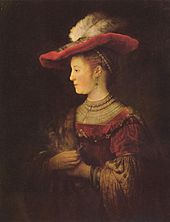Rembrandt: A Self-Portrait
| Movie | |
|---|---|
| Original title | Rembrandt: A Self-Portrait |
| Country of production | United States |
| original language | English |
| Publishing year | 1954 |
| length | 26 minutes |
| Rod | |
| production | Morrie Roizman |
| camera |
Edmund B. Gerard , Otto Peter Radl |
Rembrandt: A Self-Portrait (reference Title Rembrandt van Rijn: A Self-Portrait ) is an American documentary - short film from 1954, with the producer Morrie Roizman 1955 for an Oscar nominee.
content
The film opens with Rembrandt's self-portrait from 1659. It is said that Rembrandt Harmenszoon van Rijn, born in Leiden in 1606 as the son of a miller , became known worldwide by his first name “Rembrandt” and is considered one of the most important and well-known Dutch baroque artists . His work and creativity fell into the era of the Golden Age , a time in which the Netherlands experienced a heyday politically, economically and artistically. After completing his studies, the young painter soon attracted attention and became a celebrated artist of his time because of the portraits he made for wealthy citizens.
Self-portraits of the painter are then shown, which he began with at a young age and which included various techniques. Rembrandt consistently made portraits of himself in different life situations and different clothes and gestures as well as with changing facial expressions and in different roles, often several times. He is said to have depicted himself about fifty times in color, twenty times in etchings and about ten times in drawings.
Around 1631 Walter Lajovic painted a portrait showing Rembrandt's mother leafing through a large book. Rembrandt himself portrayed his father several times. Around 1632 Rembrandt painted his first group picture The Anatomy of Dr. Tulp , who marked his breakthrough as a portrait painter.

Two years later, in July 1634, Rembrandt married Saskia van Uylenburgh . She was the niece of his art dealer, a wealthy patrician . The couple's first son was born in December 1635, but lived only a few months old. A daughter born in 1638 also died as a baby, as did a second daughter. The couple had another son in 1641, the year Rembrandt completed his painting The Night Watch . When Rembrandt's wife, Saskia, died in 1642, it marked a deep turning point in the artist's life and significantly slowed down his artistic activity.
Despite his success, Rembrandt had to struggle with considerable financial problems at times, had to file for bankruptcy in 1656 and died a poor man in Amsterdam in 1669. His life was also marked by personal disappointments and bitter strokes of fate and by the fact that many of his contemporaries did not appreciate his pictures as they deserved.
The film is interspersed with pictures, drawings, etchings and sketches by the painter, in which events are recorded that are related to his life and show important stages. His most important pictures are dealt with in detail, for example his work Die Anatomie des Dr. Tulp , the portrait of his wife Saskia van Uylenburgh , The Night Watch , cycle of images from the childhood story of Jesus and the Passion as well as other biblical images such as The Last Supper in Emmaus , and the portrait of the man with the gold helmet, long attributed to Rembrandt .
production
The Auerbach Film Enterprises Ltd. presented and produced by Morrie Roizman in association with REVA, was distributed by Encyclopaedia Britannica Films.
Award
At the 1955 Academy Awards , Morrie Roizman was nominated for an Oscar in the Best Documentary Short Film category, but it went to World Wide Pictures and Morse Films and their Thursday's Children film about deaf children.
Web links
- Rembrandt: A Self-Portrait in the Internet Movie Database (English)
- Rembrandt van Rijn: A Self Portrait full original film at vimeo.com
Individual evidence
- ↑ The 27th Academy Awards | 1955 sS oscars.org

